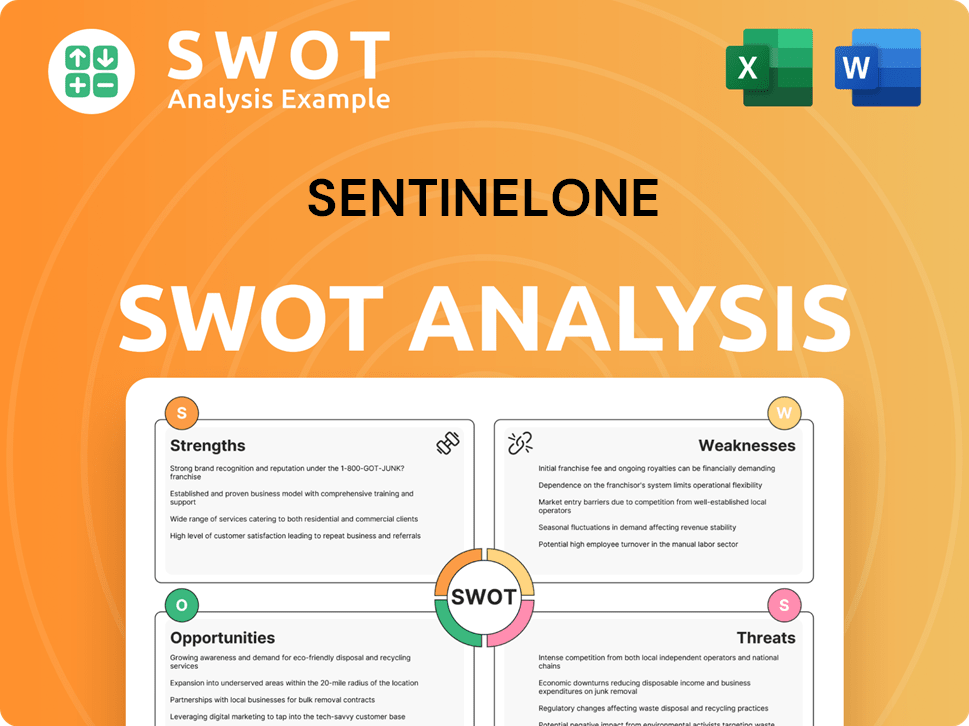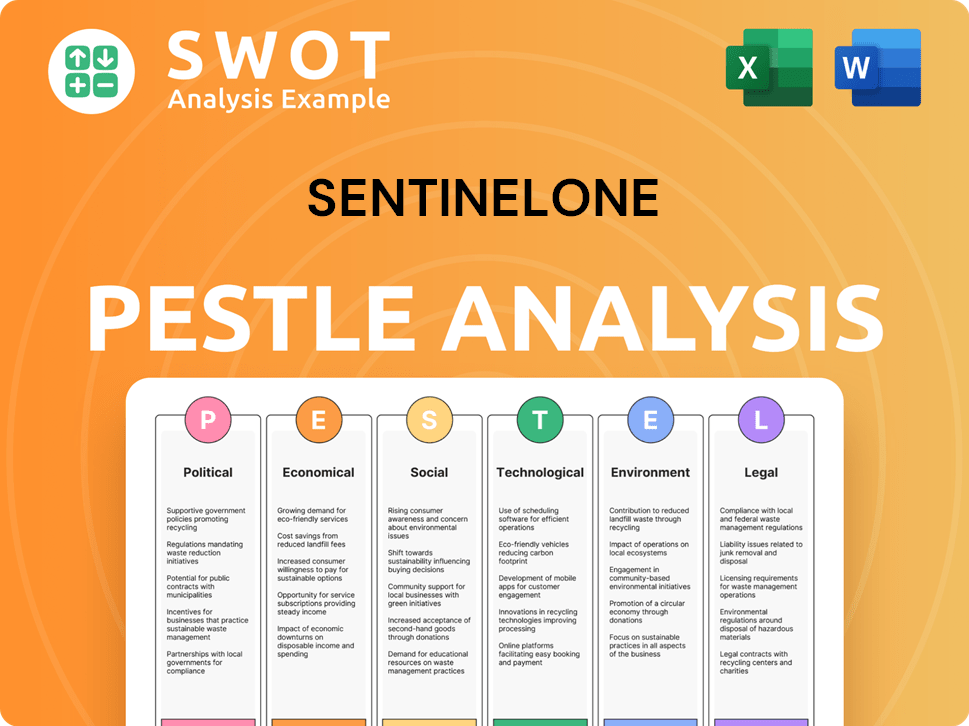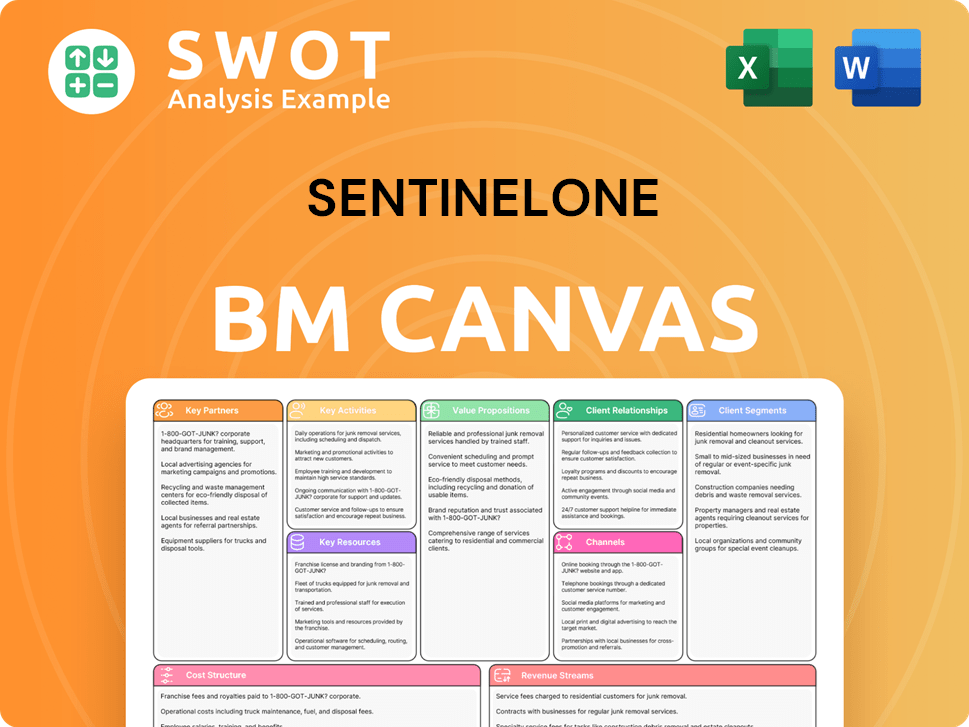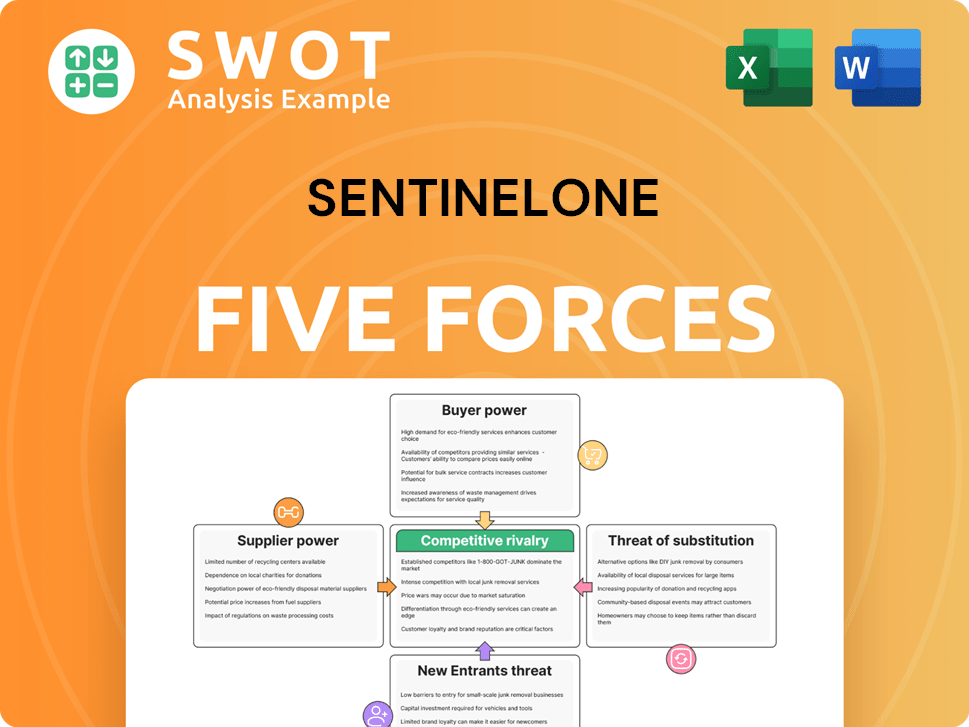SentinelOne Bundle
Can SentinelOne Continue Its Cybersecurity Ascent?
SentinelOne, a pioneer in AI-powered cybersecurity, has rapidly transformed the industry with its innovative approach to threat prevention. Founded in 2013, the company's SentinelOne SWOT Analysis highlights its strategic positioning in the evolving cybersecurity market. With a focus on autonomous cybersecurity, SentinelOne addresses the growing need for advanced endpoint detection and response (EDR) solutions.

As the cybersecurity landscape becomes increasingly complex, understanding SentinelOne's growth strategy and future prospects is crucial for investors and industry analysts. The company's impressive financial performance, including an ARR of $920.1 million as of January 2025, signals strong market demand. This analysis delves into SentinelOne's competitive landscape, expansion plans, and the potential for its continued success in the cybersecurity sector, providing insights into its long-term investment potential and revenue growth analysis.
How Is SentinelOne Expanding Its Reach?
The expansion initiatives of the company are crucial for its growth and future prospects. These initiatives are designed to broaden its market reach and diversify its revenue streams. The company's strategic moves and partnerships, such as the collaboration with Lenovo, are expected to significantly boost its market penetration, particularly in the endpoint protection space.
The company is actively expanding its geographical presence and product offerings. This includes targeting high-growth markets and enhancing its platform with new solutions. These efforts are aimed at accessing new customers, diversifying revenue streams, and staying ahead of rapid industry changes. The company's focus on innovation and strategic partnerships is key to its long-term success.
The company's comprehensive approach to growth involves strategic partnerships, geographical expansion, and product diversification. The company's commitment to innovation and strategic alliances is critical for its continued success in the cybersecurity market.
A major initiative is the partnership with Lenovo, announced in early 2025. This collaboration is expected to deliver up to 30 million endpoints over the coming years. This will significantly boost the company's market penetration in the endpoint protection space. This strategic move is expected to drive substantial revenue growth.
The company is also targeting growth in the mid-market and SMB segments. This is being achieved by leveraging partnerships with Managed Security Service Providers (MSSPs). This strategy allows the company to reach a broader customer base. This segment is a significant growth area for cybersecurity solutions.
Geographically, the company is expanding rapidly, particularly in the Middle East, including Saudi Arabia and the UAE, as well as in Turkey and Africa. These regions are recognized as transformational markets with significant cybersecurity challenges. This expansion aims to capitalize on the increasing demand for secure infrastructures.
The company is expanding beyond traditional endpoint security. Non-endpoint solutions are driving higher customer spend. Recent product launches and enhancements within its Singularity Platform include Singularity Cloud Workload Security and Singularity Identity. The company is also focusing on enhancing its platform capabilities.
The acquisition of PingSafe in January 2024 for over $100 million integrated PingSafe's cloud-native application protection platform (CNAPP). This integration with the company's AI-powered solutions created a unified security platform. This strategic move enhanced the company's capabilities.
- Singularity Cloud Workload Security protects containers and Kubernetes environments.
- Singularity Identity provides Active Directory exploitation protection.
- Ranger Insights monitors and secures unmanaged devices.
- Singularity Data Lake offers a centralized platform for security data analysis and threat hunting.
These initiatives are designed to access new customers, diversify revenue streams, and stay ahead of rapid industry changes. For more insights, you can check out the Marketing Strategy of SentinelOne.
SentinelOne SWOT Analysis
- Complete SWOT Breakdown
- Fully Customizable
- Editable in Excel & Word
- Professional Formatting
- Investor-Ready Format

How Does SentinelOne Invest in Innovation?
The growth strategy of SentinelOne is deeply rooted in innovation and technological advancement, especially in the realm of artificial intelligence (AI). The company's approach to cybersecurity is centered on AI-driven, autonomous solutions. This focus aims to establish Singularity as the leading AI security platform, fundamentally reshaping how cybersecurity challenges are addressed. This positions SentinelOne uniquely within the cybersecurity market.
SentinelOne's commitment to research and development (R&D) and in-house development is evident in its continuous enhancements to the Singularity Platform. The company's investments in AI and automation are designed to provide superior protection and response capabilities. These advancements are crucial for maintaining a competitive edge and driving future growth.
SentinelOne's dedication to innovation is also reflected in its consistent performance in industry evaluations, securing its position as a leader in the cybersecurity sector. The company's focus on AI-powered protection, utilizing both static and behavioral AI, is a key differentiator. This strategy is supported by key patents in machine learning security models, underscoring their expertise in the field.
SentinelOne is focused on AI-driven innovation to solidify its position in the cybersecurity market. This includes the development of fully autonomous, agentic AI workflows, with the goal of establishing Singularity as the leading AI security platform. This approach aims to redefine how cybersecurity challenges are addressed.
The Singularity Platform receives continuous enhancements through significant R&D efforts. In 2025, notable updates include the introduction of Purple AI. These innovations build on Purple AI's native agentic capabilities to automate and accelerate threat triaging, investigation, and response.
Purple AI is an automation tool that enhances security workflows, and the 'Athena' release brings deep security reasoning and agentic AI capabilities. This release will also open Purple AI to third-party SIEM platforms and data lakes. This expands the reach of SentinelOne's AI and automation across all security data.
SentinelOne's performance in industry evaluations underscores its commitment to innovation. The Singularity Platform achieved 100% detection with zero delays in the MITRE ATT&CK 2024 Enterprise Evaluations. The company was also recognized as the best performing vendor on the Frost Radar: Endpoint Security, 2025.
SentinelOne employs AI-powered protection, utilizing both static and behavioral AI. This approach is designed to prevent advanced malware and automate ransomware remediation. Key patents in machine learning security models support their expertise in this area.
The company’s focus on AI-driven, autonomous solutions sets it apart in the cybersecurity market. Continuous enhancements to the Singularity Platform and strong performance in industry evaluations highlight their competitive advantages. This includes the use of AI-powered protection.
SentinelOne's technology strategy is centered on AI and automation to enhance its security platform. The company's focus on innovation is evident in its product roadmap, including the development of Purple AI and its integration with third-party platforms. This approach is designed to drive revenue growth and increase market share.
- AI-Native Autonomous Security: SentinelOne is pioneering AI-native autonomous security, aiming to redefine cybersecurity.
- Singularity Platform: Continuous enhancements to the Singularity Platform are driven by significant R&D investments.
- Purple AI: The introduction of Purple AI and the 'Athena' release enhances security workflows.
- Industry Recognition: The Singularity Platform's performance in evaluations, such as the MITRE ATT&CK, highlights its effectiveness.
- AI-Powered Protection: SentinelOne uses both static and behavioral AI to prevent advanced malware and automate ransomware remediation.
- Competitive Landscape: The company competes with other cybersecurity providers in the endpoint detection and response (EDR) market. Learn more about the SentinelOne vs CrowdStrike comparison.
SentinelOne PESTLE Analysis
- Covers All 6 PESTLE Categories
- No Research Needed – Save Hours of Work
- Built by Experts, Trusted by Consultants
- Instant Download, Ready to Use
- 100% Editable, Fully Customizable

What Is SentinelOne’s Growth Forecast?
The financial outlook for SentinelOne reflects a strategy focused on sustainable growth and improved profitability. The company aims to achieve a 20% operating margin over time. This outlook is supported by strong recent financial performance and strategic initiatives aimed at expanding its market presence and product offerings. A brief history of SentinelOne provides context for understanding its growth trajectory.
For the fiscal year 2025, which ended on January 31, 2025, SentinelOne reported robust financial results. Total revenue reached $821.5 million, marking a 32% year-over-year increase. Annualized recurring revenue (ARR) also saw significant growth, increasing by 27% to $920.1 million as of January 31, 2025. These figures highlight the company's strong position in the cybersecurity market and its ability to attract and retain customers.
The company anticipates surpassing $1 billion in both ARR and revenue in fiscal year 2026. This projection indicates continued expansion and market penetration. This growth is crucial for the company's long-term success and its ability to compete in the cybersecurity market. The company's focus on innovation and customer satisfaction is expected to drive further growth.
SentinelOne achieved its first quarter of positive non-GAAP operating margin in Q4 fiscal year 2025, reaching 1%, a significant improvement. The company's focus on operational efficiency and cost management has contributed to this positive trend. This improvement in profitability is a key indicator of the company's financial health and its ability to generate sustainable returns.
For the full fiscal year 2025, the non-GAAP operating margin was (3)%, a notable improvement from (19)% in fiscal year 2024. The non-GAAP net income margin was 5% in Q4 fiscal year 2025. These improvements reflect the company's progress in managing its expenses and increasing its revenue base. The company's financial performance demonstrates its ability to scale its operations while improving profitability.
SentinelOne reported positive free cash flow for the trailing-twelve-month basis in fiscal year 2025. This indicates the company's ability to generate cash from its operations. Positive free cash flow is essential for funding future growth initiatives and maintaining financial flexibility. The company's strong cash position supports its ability to invest in research and development and expand its market presence.
For the first quarter of fiscal year 2026 (ending April 30, 2025), SentinelOne provided guidance of $228 million in revenue. For the full fiscal year 2026 (ending January 31, 2026), revenue is projected to be between $1,007 million and $1,012 million. These projections indicate continued growth. The company's guidance reflects its confidence in its ability to execute its growth strategy and capitalize on market opportunities.
While analysts expect revenue growth to slow to 26% in fiscal year 2026, this rate still exceeds the forecast industry CAGR. This demonstrates the company's ability to outperform its competitors and maintain a strong growth trajectory. The company's focus on innovation and customer satisfaction is expected to drive continued revenue growth.
SentinelOne's cash, cash equivalents, and investments stood at $1.1 billion as of January 31, 2025. This strong cash position provides the company with financial flexibility to invest in growth initiatives, research and development, and potential acquisitions. The company's robust financial position supports its long-term growth strategy and its ability to capitalize on market opportunities.
SentinelOne Business Model Canvas
- Complete 9-Block Business Model Canvas
- Effortlessly Communicate Your Business Strategy
- Investor-Ready BMC Format
- 100% Editable and Customizable
- Clear and Structured Layout

What Risks Could Slow SentinelOne’s Growth?
The cybersecurity landscape presents several potential risks and obstacles for the growth of SentinelOne. The company, despite its advancements, faces challenges related to market competition, technological disruption, and regulatory changes. These factors, along with internal resource constraints and economic uncertainties, can impact its strategic initiatives and financial performance.
Intense competition within the cybersecurity market, particularly from established players, puts pressure on SentinelOne's growth. Rapid technological advancements and evolving cyber threats require constant innovation and significant investments in research and development. Moreover, internal resource limitations and economic factors can further complicate the company's trajectory.
A recent service disruption in early June 2025, while not a cyberattack, highlighted the need for robust infrastructure and risk management. This, combined with the ongoing challenges, underscores the complexities SentinelOne faces as it navigates the cybersecurity market and pursues its growth strategy. For a deeper understanding of the company's foundational principles, consider exploring the Mission, Vision & Core Values of SentinelOne.
The cybersecurity market is highly competitive. Companies like CrowdStrike and Palo Alto Networks are major competitors, which increases customer acquisition costs. This competition can affect profit margins and overall SentinelOne company analysis.
Rapid evolution of threats is a constant challenge. This includes AI-driven attacks and supply chain attacks, which require continuous innovation. Maintaining a leading edge demands substantial R&D investment for SentinelOne's future prospects.
Organizations must navigate complex regulations. Failure to comply can lead to significant costs and reputational damage. This impacts SentinelOne's growth strategy and its ability to secure new customers.
Attackers target third-party software. These attacks can compromise multiple organizations. SentinelOne actively reports on these pervasive supply chain attacks, highlighting the need for robust security.
The cybersecurity talent shortage hinders growth. In 2024, security headcount growth slowed significantly. Existing teams manage more responsibilities with fewer resources, affecting SentinelOne's market share.
Economic uncertainties can impact budgeting. Geopolitical factors can also influence business decisions. These factors may lead to softer enterprise spending, affecting SentinelOne's financial performance.
A global service disruption occurred in early June 2025. This highlights the ongoing need for robust infrastructure and risk management. This event, though not a cyberattack, underscores the importance of business continuity for SentinelOne cybersecurity solutions.
SentinelOne currently operates at a loss. The company faces pressure on pricing power due to competition. These financial realities are important for understanding SentinelOne's investment potential.
SentinelOne Porter's Five Forces Analysis
- Covers All 5 Competitive Forces in Detail
- Structured for Consultants, Students, and Founders
- 100% Editable in Microsoft Word & Excel
- Instant Digital Download – Use Immediately
- Compatible with Mac & PC – Fully Unlocked

Related Blogs
- What are Mission Vision & Core Values of SentinelOne Company?
- What is Competitive Landscape of SentinelOne Company?
- How Does SentinelOne Company Work?
- What is Sales and Marketing Strategy of SentinelOne Company?
- What is Brief History of SentinelOne Company?
- Who Owns SentinelOne Company?
- What is Customer Demographics and Target Market of SentinelOne Company?
Disclaimer
All information, articles, and product details provided on this website are for general informational and educational purposes only. We do not claim any ownership over, nor do we intend to infringe upon, any trademarks, copyrights, logos, brand names, or other intellectual property mentioned or depicted on this site. Such intellectual property remains the property of its respective owners, and any references here are made solely for identification or informational purposes, without implying any affiliation, endorsement, or partnership.
We make no representations or warranties, express or implied, regarding the accuracy, completeness, or suitability of any content or products presented. Nothing on this website should be construed as legal, tax, investment, financial, medical, or other professional advice. In addition, no part of this site—including articles or product references—constitutes a solicitation, recommendation, endorsement, advertisement, or offer to buy or sell any securities, franchises, or other financial instruments, particularly in jurisdictions where such activity would be unlawful.
All content is of a general nature and may not address the specific circumstances of any individual or entity. It is not a substitute for professional advice or services. Any actions you take based on the information provided here are strictly at your own risk. You accept full responsibility for any decisions or outcomes arising from your use of this website and agree to release us from any liability in connection with your use of, or reliance upon, the content or products found herein.